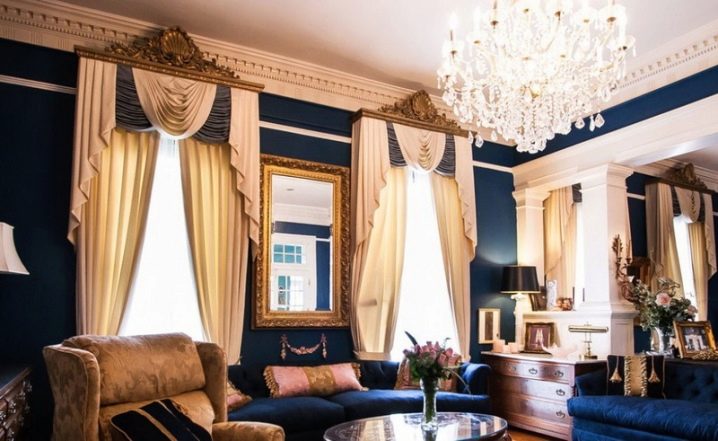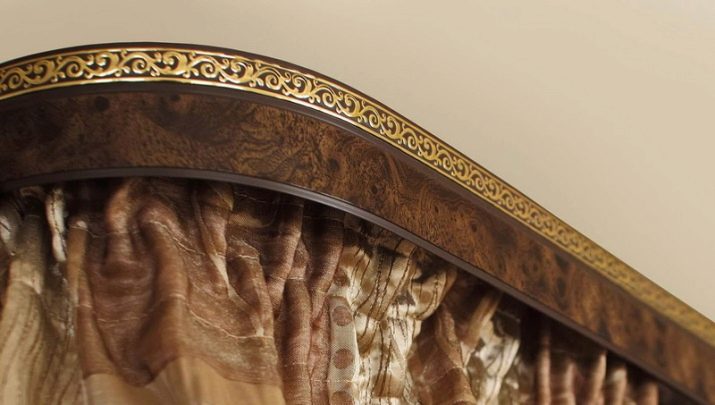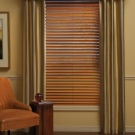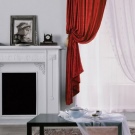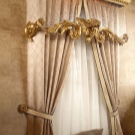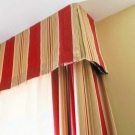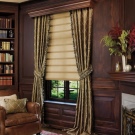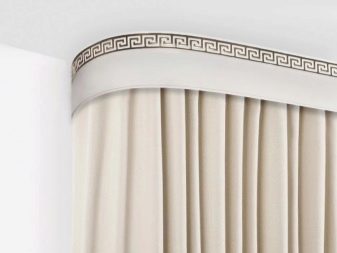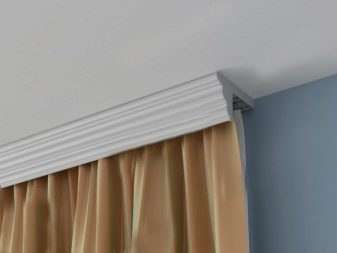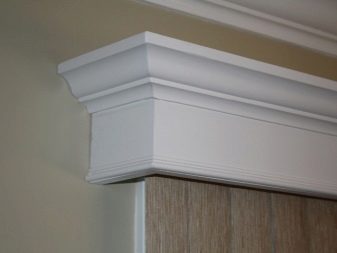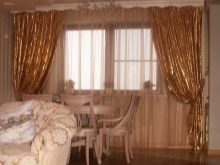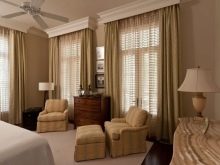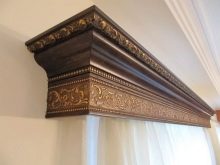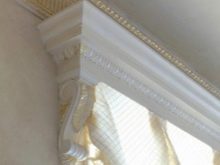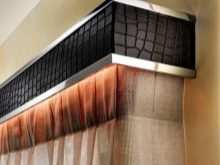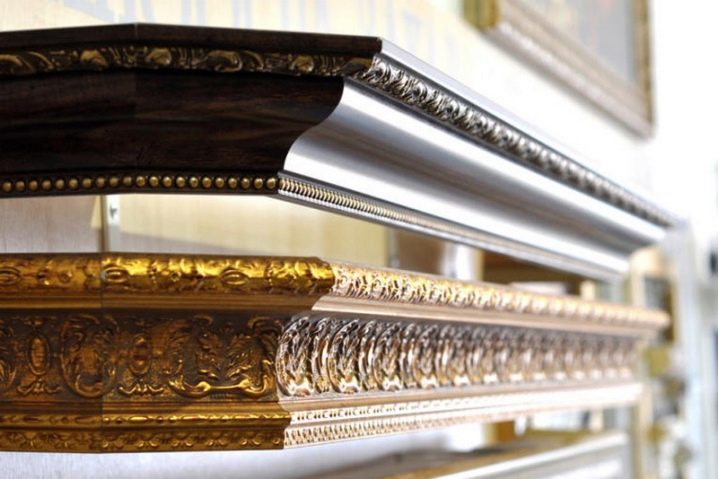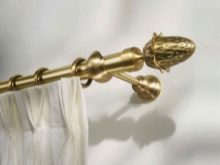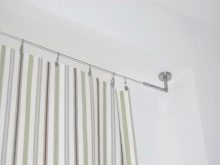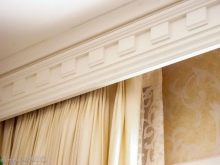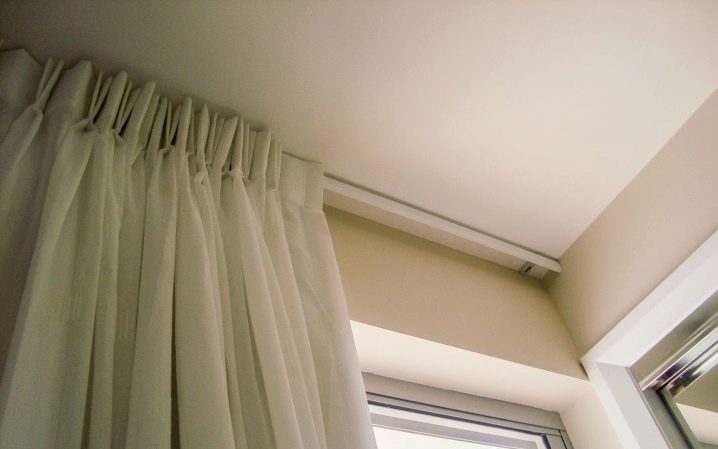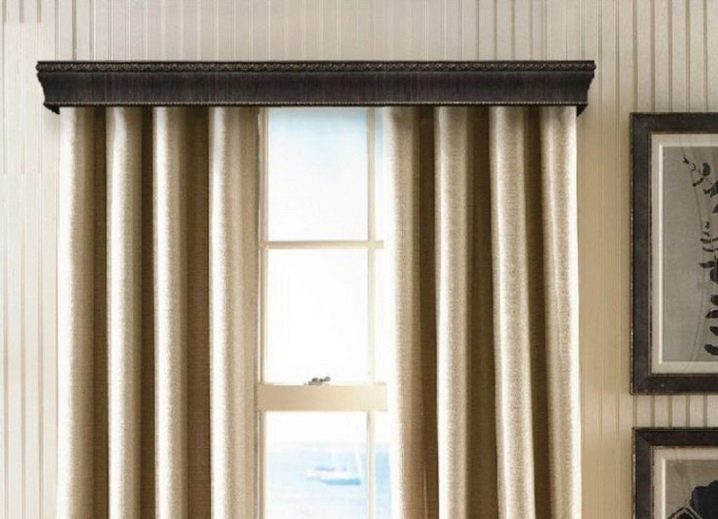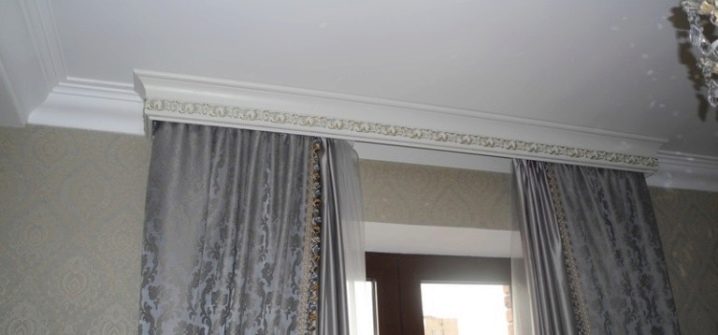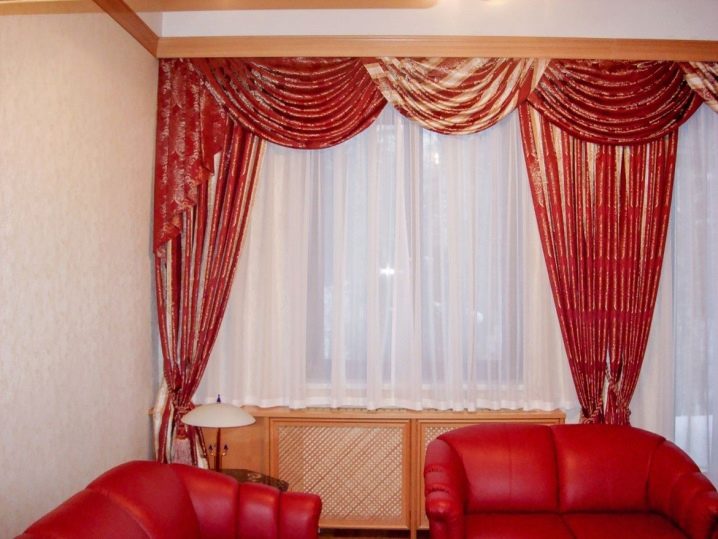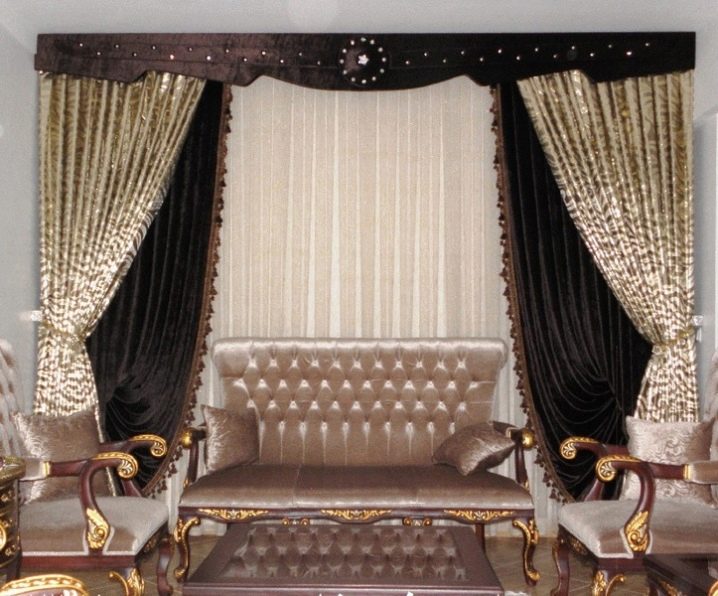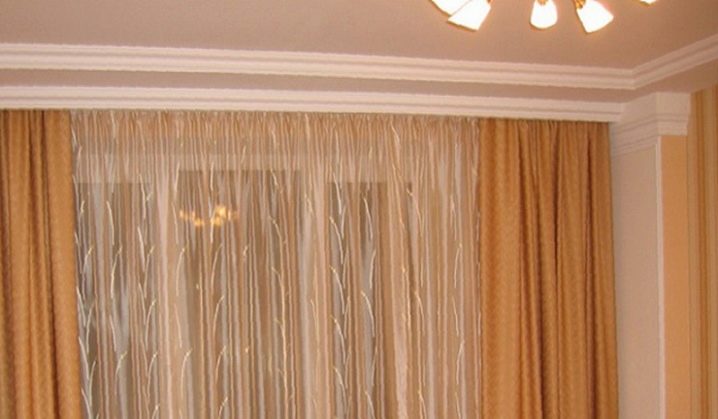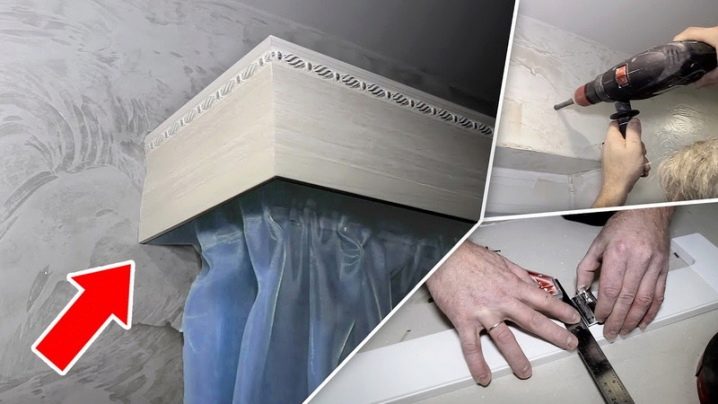Baguettes for curtains: views and installation tips
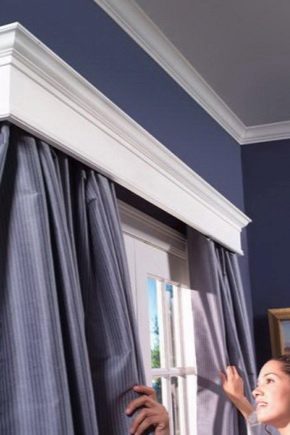
There are not so many types of fastening of curtains, but nevertheless the choice is quite wide. Round bars and strained strings, aluminum profiles and baguettes - there is something to think about when choosing the appropriate option. It is about the latter that will be discussed in our article: what is a baguette, what are the types of baguettes, as well as the ways in which they can be fixed.
What it is?
Baguette for curtains - one of the types of cornice. Its distinctive feature is that all the details with which it is attached to the wall are covered with a special strip. It is thanks to this strip that the curtain smoothly passes into the ceiling, and the place of their joint is completely not noticeable.
Most often such attachments are used there,where the curtains have many layers, and the eaves, respectively, many rows, and if they are not hidden, the top of the structure will look cumbersome and unattractive. The baguette fits well into a room where there is not enough space to hang a simple cornice, that is, into any small apartment. That is why baguettes are increasingly used for decorating city apartments.
Advantages and disadvantages
Like any other decoration method, the baguette has its advantages and disadvantages. Let's start with the first.
What is good baguette:
- This mount is optimal in rooms where the ceiling height is greater than the standard. As a rule, in such a layout, the windows are also different from the generally accepted sizes, so you will need longer and wider curtains. To sustain their weight, you need a very strong eaves, as the standard can bend or simply break. Since the baguette is able to hold the heaviest curtains, it is used in such rooms.
- In the rooms where the windows go "right up" to the ceiling, and the ceilings themselves are low (this is the fault of, for example, "Khrushchev") - you cannot place a usual cornice. And the ceiling baguette perfectly fits into the interior and saves a bit of space, at the same time visually enlarging the room, “stretching” it upwards.
- Due to the weight of curtains, it is better to use this method of fastening on windows of non-standard width (in houses of new layouts or country cottages), since it will not “squeeze” and will not bend in unwanted places.
- For lovers of chic and luxury who want to protect their bed with a canopy, baguette is also suitable, but only, of course, the ceiling one. In addition, this method of fastening the eaves is ideal for those who wish to zone the space with curtains.
- Japanese frame curtains need to be fixed only with a baguette, and only rail.
This type of fastening is practically not a thing that can be called a disadvantage: its prices are average, it is made of various materials - from metal profiles to PVC. The only thing in which he may not be suitable is not to “fit in” with the style in which the room is decorated, or else the owner simply does not like it.
Manufacturing materials
Choosing which baguette to use in order to hang your curtains, you need to look not only at the style or design, but also necessarily at the material from which it is made. This is the only way to ensure a long life of both the curtain track and the curtain composition.
So baguette can be:
- metal;
- wooden;
- plastic.
Each has its pros and cons.
- The most reliable is metal. It can withstand a multi-layered curtain design of heavy drape fabric. It does not rust, and only its considerable price can scare the buyer.
- The wooden baguette is also durable, but not suitable for use in rooms with moist air, for example, in a kitchen or bathroom with a window.
- The most fragile is plastic, but it will perfectly cope with maintaining curtains of flying fabrics, even multi-layered ones. In addition, plastic is indispensable for irregularly shaped windows: arched, bay windows, various geometric shapes, since it can be bent and the necessary shapes can be formed from it.
- For decorative baguettes, plaster or polyurethane is also used. They can not hang curtains, they only mask the cornice. Such details are very beautiful, but, as a rule, they quickly lose their color saturation and are extremely fragile.
Types of mounts
According to the type of attachment, baguettes can be rod, rail and string. The first ones are real "heavyweights", it is on them that the heaviest structures are attached.Multi-row curtains will “stand up” well on rail rails, as the “rail” has hooks on which several layers can be fastened. Strings are suitable for airy, light curtains of tulle, taffeta or veil.
Baguette can have one, two or three rows. Fastening for it can be provided both wall and ceiling.
Style
Deciding what material will be used for the baguette, and how the curtain will be strengthened, is half the battle. The style of the room is no less important, because you need to harmoniously "fit" into it the eaves.
First of all, it is necessary that the baguette is combined with a curtain composition. If your curtains are airy and flying, then the forged cornice will “crush” them, and if the curtains are solid, massive, then the frivolous twisted baguette will look frivolous and out of place. The size of the room is also important - a small room heavy curtains and a wide cornice will further reduce. Care should be taken with a large print on the curtain, and with an abundance of details on the eaves, and with accessories on the curtains - pickups, bows, loops.
In country houses with high ceilings and plenty of space, you can fantasize as you please.However, country or Provence do not tolerate an abundance of stucco, and modern does not tolerate simple wooden details. Therefore, even if the house is spacious, with high ceilings, but from a solid bar, with its decoration in Art Deco style, difficulties may arise.
Color solutions
Choose a hue baguette is equally important. The general rule is this: light tones visually expand a small room and add height to it, while dark ones “break” a wall with a ceiling, creating a clear border between them. That is why rich shades and dark colors should be used only in a room with a high ceiling and only where it is justified from the point of view of style, for example, in art deco or modernity is permissible and it is even desirable that the contour of the ceiling be clearly highlighted.
Again, it should be remembered that any frilly styles with an abundance of details (Art Deco, Baroque, Modern) would be best to look at the premises of a large area. A small room will simply disappear under a load of stucco, exquisite bows, figurines and parts. Wanting to visually increase the height of the ceiling, it is better to choose a baguette to match with him. Even better, if the shade of curtains will differ by a maximum of two tones. Then the room will receive additional volume.
If the portiere is printed or textured, has decorative elements (bows, holders, tie, jabot), the cornice is better to choose solid and harmonious in shade. Golden or silver shade looks very elegant and noble, it is suitable for the living room, dining room or bedroom. Also for the bedroom an interesting solution will be a baguette with built-in lighting. First, it adds comfort, and secondly, in an ensemble with LEDs or spotlights on the ceiling, it can create an interesting play of light and shadow.
How to hang?
The cornice-baguette is attached just like any other cornice. It can be ceiling or wall, and the place of attachment will depend on it. If you want to properly hang a decorative plaster or polyurethane baguette, then the sequence of actions will be different.
- First you need to attach the main bearing eaves. After that, attach a decorative baguette to it and make sure that there are no large gaps and spaces between it and the wall. If they are, it is necessary to level the wall, and further installation should be carried out only after the putty has completely dried.
- For fixing the corner baguette you need to cut it to the length that you need, the cut is made at an angle of 45 °. If the mount is straight, then the cut is made perpendicularly.The saw cut is cleaned with sandpaper having a medium or low abrasiveness.
- Glue is applied along the entire length of the baguette, including in the place of the cut. After applying the adhesive, press the part tightly to the place where you plan to fix it. It is necessary either to hold the construction until the glue is completely dry, or to fix it with scotch tape so that the baguette does not crawl down under its own weight.
- If excess glue has protruded around the part, they should be carefully removed with a lint free cloth (clean, of course).
- After the glue has completely dried, check again for gaps. If they are, they need to be puttied. If they are not, you can immediately treat the surface of the part with emery paper.
- Next, paint the baguette in any desired color.
About how to hang baguettes for curtains with your own hands, see the next video.
